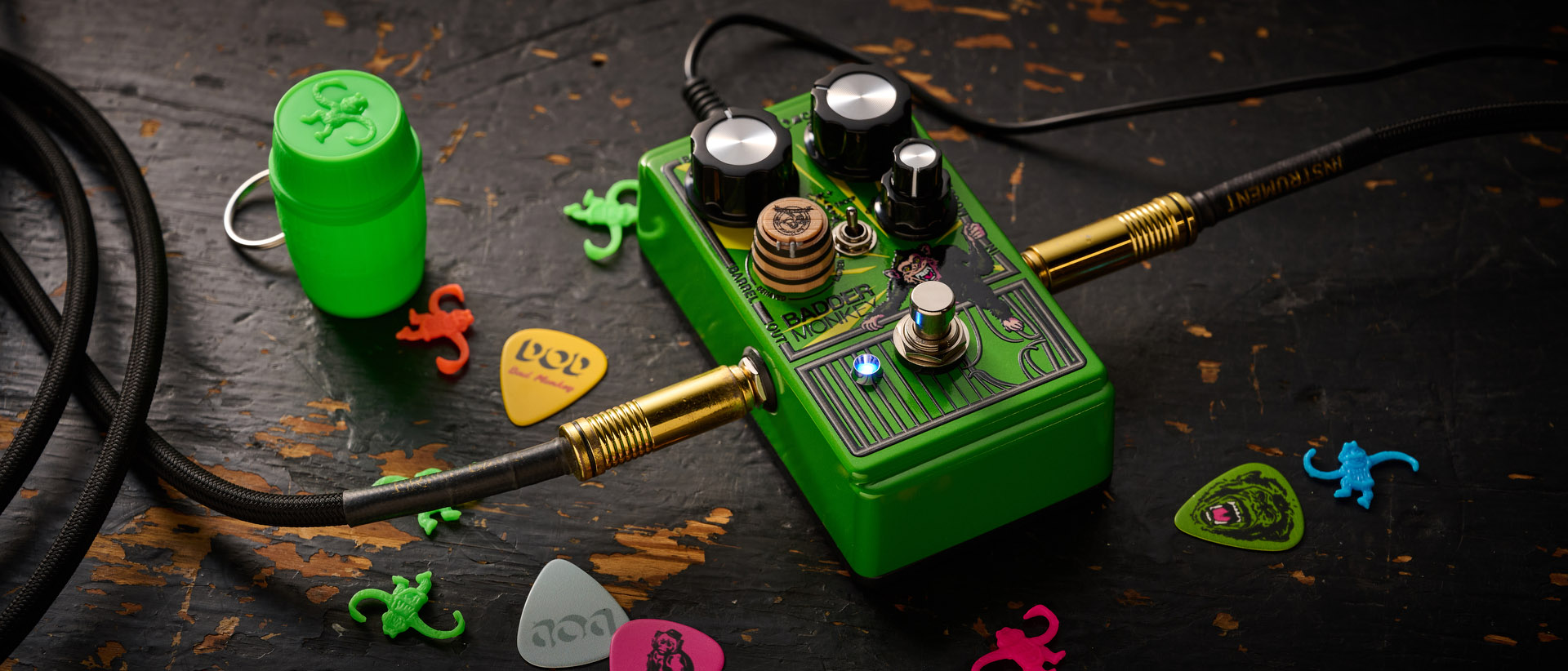How guitar relic'ing took over the world
Fender, Gibson and more tell the story of new guitars made old, from the very first relic experiments to today's sought-after Custom Shop replicas
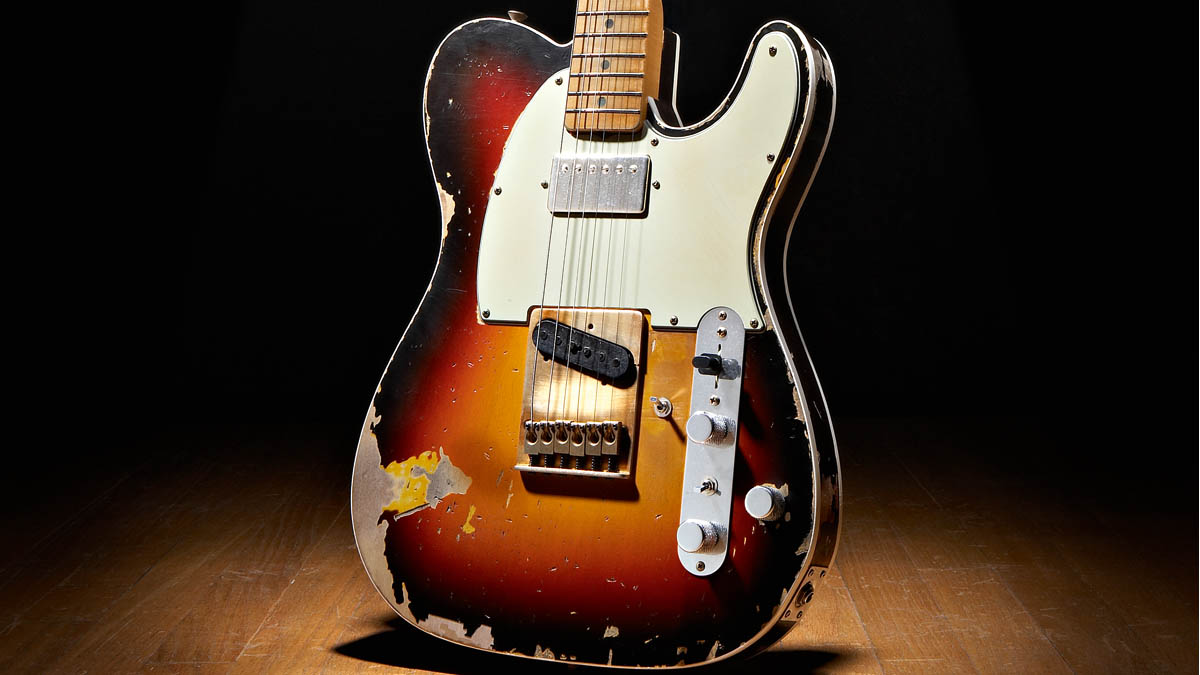
Many of us love old guitars because of what they are. And it seems we even love guitars that look like old guitars, because of what they pretend to be. The knocks and dings that a real old, worn guitar accumulates are mementoes of actual events.
That bash there happened when it fell down the stairs at that terrible session, remember? This bit here is where my elbow’s rested the last x-hundred-and-something gigs. Flip it over and that’s where my fave belt buckle has left its unreadable signature.
An aged new guitar, however – the type we often call a relic – is an ersatz axe. And usually it’s someone else’s take on the history of dings. Nonetheless, you could take matters into your own hands, a potentially dangerous move that might involve sandpaper, steel wool, hair dryers, freezers, bunches of keys, bathroom cleaner, vinegar, gougers, files, cold tea or coffee, oxidising fluid, Tung oil, French polish, razor blades, and other fearsome tools of the trade.
In their favour, relics are good to go, anywhere you like, without the fear of damaging a valuable vintage collectable. There’s always the worry with a wallet-emptying vintage piece over the authenticity of the paint finish, the rightness of a pickguard screw, the veracity of its solder joints. A new-old guitar at least takes away any nagging doubts about originality.
Fender finds a relic
Early in 1995 when Fender showed off a few early samples of its new guitars with aged finishes at the NAMM gear show in Anaheim, some of the repairers who wandered by must have wondered what all the fuss was about.
Many of them regularly did jobs where they would refinish and restore guitars, merging visible repairs into the overall vibe of the older instrument, carefully blending the look so that the new areas sat comfortably with the original worn guitar. Some of them might even have ventured occasionally into the murky world of forgeries.
Fender’s idea was to adapt these existing techniques and apply them to new instruments, creating the look of vintage wear and tear on a guitar fresh from the production line. JW Black, a builder who had started at the Custom Shop in 1989, saw an aged Strat that a friend of his, Vince Cunetto, had made. Black in turn showed it to the Custom Shop’s boss at the time, John Page. They were impressed.
All the latest guitar news, interviews, lessons, reviews, deals and more, direct to your inbox!
It started almost as a tongue-in-cheek thing, like worn-in Levi’s
John Page, Fender Custom Shop
Black came up with the idea of offering aged replicas called Relics as a regular line in the Custom Shop catalogue. “It started almost as a tongue-in-cheek thing,” Page told me, “like worn-in Levi’s or something. It would look cool, and in the first three rows it would look like you’re playing a valuable Nocaster – but only you know that it’s not really. That was how it started.”
Black and Cunetto made two aged 50s-era samples. There was a Nocaster, the transitional Broadcaster/Telecaster with the model name snipped from the headstock decal, and there was a ‘Mary Kaye’ Stratocaster, the nickname for a Strat with blonde body and gold-plated metalwork.
“We took them to the January ’95 NAMM Show,” Page said, “and we put them under glass cases like they were pieces of art. Visitors would came along and say, ‘Oh, that’s really cool: you brought original ones as a tribute.’ And we were saying, ‘Er, yeah… how many do you want?’ People went nuts! It was amazing.”
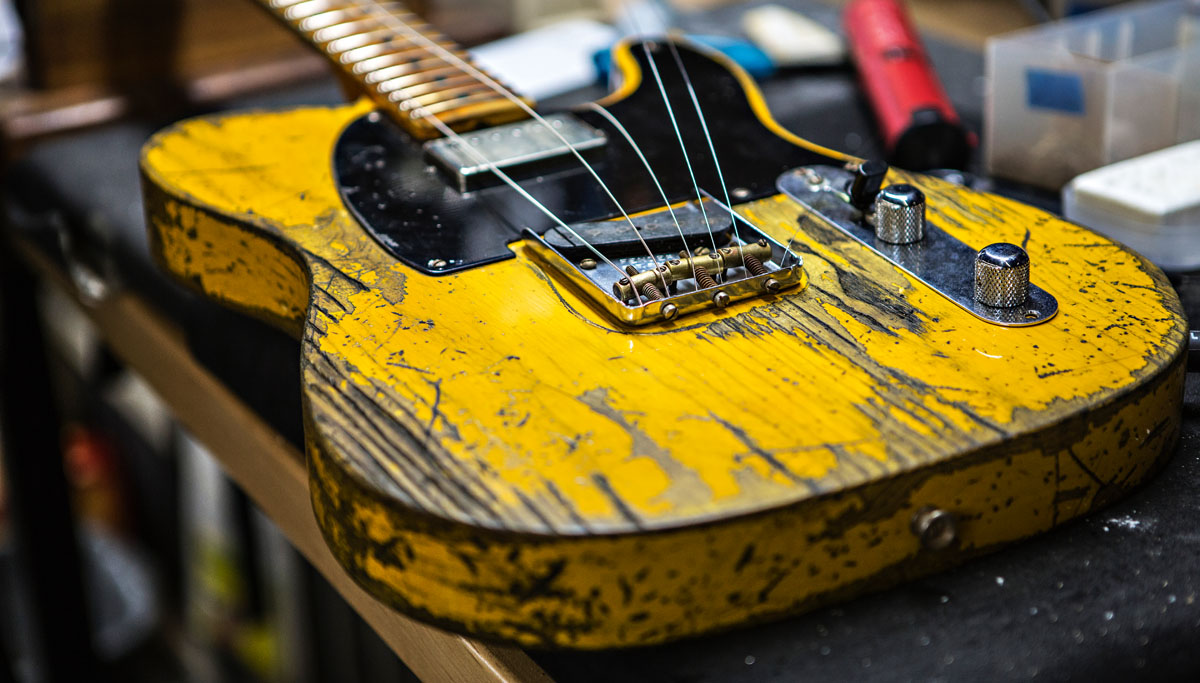
Soon, the Custom Shop was reacting to the demand and it began to offer a line consisting at first of a Relic Nocaster and a few 50s and 60s Relic Strats, expanding to include a 60s Jazz Bass and various sunbursts and colours.
Starting work on the project in summer ’95, Cunetto and a small team at his workshop in Missouri would receive bodies, necks and parts from Fender, shoot nitrocellulose lacquer, and then set about the ageing processes. Back to Fender the bits would go, where the final assembly and setup of the guitars was completed.
A few years later, the work shifted entirely to the Fender Custom Shop, overlapping with Cunetto’s ’shop around the end of 1998 and into ’99. Cunetto once estimated that he’d made 4,800 of the aged Fenders between 1995 and 1999. In-house, Fender established three strands of the re-creations in ’99, the Relic (heavily worn), the Closet Classic (as if played a few times then shoved in a cupboard), and NOS (New Old Stock, as if bought new in the 50s/60s and then transported to now by time machine).
Aside from the Custom Shop, in 2009 Fender introduced a line of aged models made in the Mexico factory. They were called Road Worn, a finish that had debuted on Mexico’s Joe Strummer Telecaster of 2007. The new Road Worn models were a 50s and 60s Strat and a 50s Tele, lasting in the line until 2018. Fender’s latest offerings simply include a number of finishes described as “aged”, while Road Worn seems limited now to a few artist models, such as the Brad Paisley Road Worn Telecaster.
Time Capsule is an old guitar never removed from the case and box. It really looks like a brand new ‘old’ guitar that’s never been touched
Mike Lewis, Fender
The overall name Fender used for the Custom Shop aged models was first seen in 1999: the Time Machine series. Mike Lewis, VP of Product Development at the Custom Shop, describes the current Time Machine finishes, in ascending levels of ageing, as follows.
NOS, he says, is a finish that looks brand-new and shiny, with no ageing, while “Time Capsule is an old guitar never removed from the case and box”, Lewis continues. “Body and neck finish have only a mild sheen, hardware a slight patina – it really looks like a brand new ‘old’ guitar that’s never been touched.”
Fender’s Closet Classic aims to look as if it was bought new, played a little, but mostly left in the case or on the wall. Lewis says it shows no real playing wear but more subtle indications of age, such as a finish that’s lost its sheen, mild discolouration of plastic parts, metal hardware showing slight oxidation, and minor surface scratches on the body and headstock.
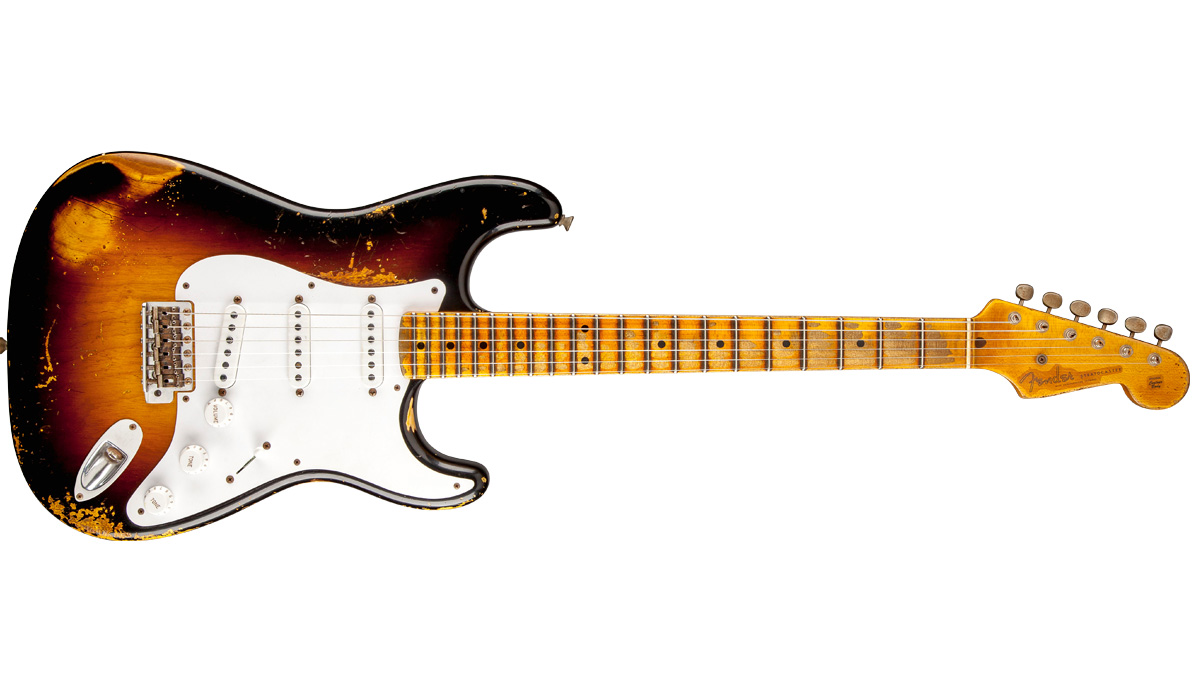
“DLX Closet Classic guitars have been well taken care of, religiously polished through the years,” he says. “The owner took pride keeping it clean and shiny. Over time, the finish started showing age and, like a fine wine, it evolved into something complex and refined, with moderate finish checking, oxidation of hardware, and mild discolouration of parts.”
The Journeyman Relic finish looks as if the guitar has been used but not abused, Lewis explains. “Handed down or changed hands through the years but mostly played around the house, the Journeyman has seen the occasional jam session or weekend gig. Well taken care of over the years but has finish checking, some ‘friendly’ down-to-the-wood nicks and dings, Relic hardware and moderate playing wear. A very lucky find!”
The original Relic has authentic worn-in wear as if from many years of regular use in clubs and bars, according to Lewis. “The marks tell a story, with finish checking all over the body, and scars, dings and dents from bridge to headstock. Last is the Heavy Relic, which has hard-fought wear and tear. It’s designed to evoke decades of the most punishing play and touring, from serious dinging and wear to intensely discoloured hardware and finish. The true battle-hardened workhorse!”
Nobody does it like we do. Each guitar tells a story and no two are the same – unless the customer requests it, or it’s a replica of something
Mike Lewis, Fender
Lewis says Fender was the first to do this: “And nobody does it like we do. Each one tells a story, and no two are the same – unless the customer requests it, or it’s a replica of something. Through the years we’ve had the opportunity to inspect hundreds of vintage guitars and, as you can imagine, there are endless ‘stories’ told in the wear and tear. These stories are the prime inspiration for the evolutions in style and additions to our offerings.”
Fender’s Time Machine series has proved a long-running success, the nearest the brand has come with new instruments to the almost indefinable cool of vintage guitars. Some thought this mystical quality was like the specific blue used in medieval stained glass: permanently and irretrievably lost in the past. Some still do.
Gibson gets VOS
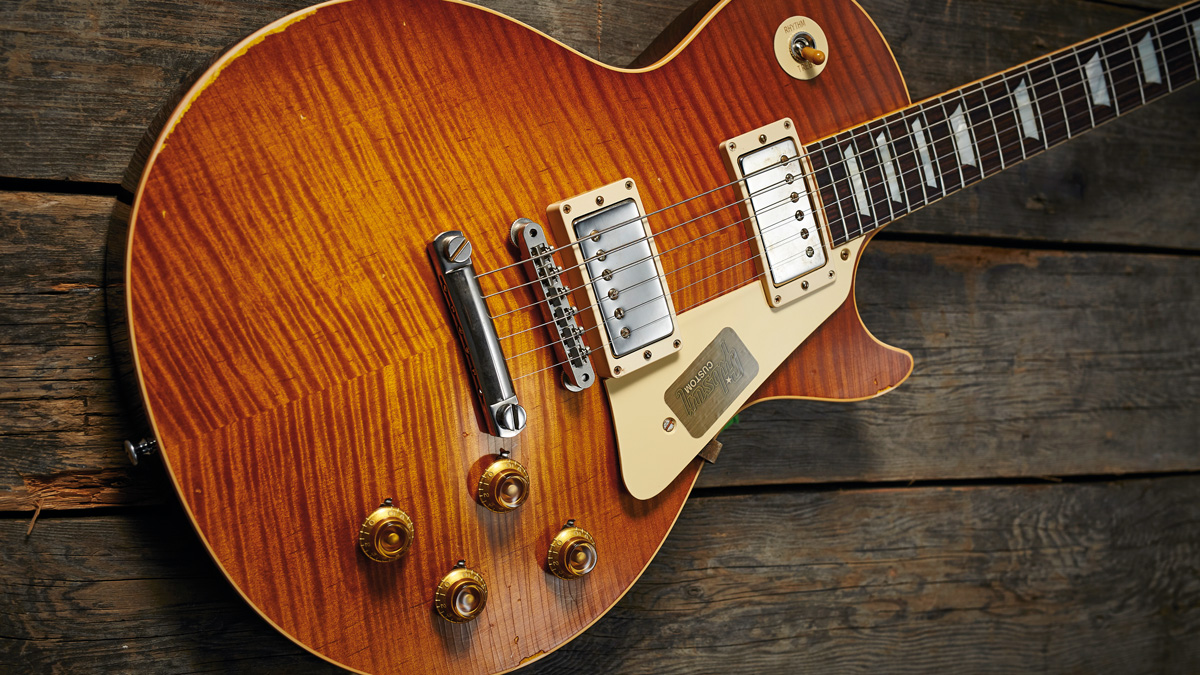
Like Fender, Gibson took to the new-old notion of aged finishes, at first with the help of Tom Murphy, who in 1999 began providing Gibson with an aged version of the Custom Shop’s Les Paul ’59 Reissue.
The paint colours were made to appear faded, nickel-plated parts (such as the pickup covers) were realistically tarnished, and the lacquer was checked and effectively dulled. Murphy had worked at Gibson from 1989 to 1994, when he set up his own Guitar Preservation company, specialising in guitar restoration. He prefers to call this aspect of his work a “broken-in” feel rather than an aged look.
“I do whacky stuff to the finish that simulates things that old guitars encounter over the years,” Murphy told me, “like heat, cold, scratching, dinging, all of that. It somehow emulates all that wear and stuff.”
And the secret to the ageing process? “I can’t tell you that,” Murphy said with a smile. “I can tell you it’s done by hand, though – but that’s just because it’s the only way it can be done. I swear that if we could do it with a laser, we’d have the laser version and the hand-done version.
But we can’t. It would be great if we had a magic box to put them in, a time machine or something where we could just switch it on to, say, winter in Minnesota, 1959. But we can’t do that.” Not yet, anyway.
As the availability of the original guitars diminished, restoring an old one became more necessary
Tom Murphy
Burst in 2004 a crucial job in the development of those processes. “That was a very high-profile project,” he said. “I had techniques by then of laying vast numbers of objects – nuts, bolts, screws, washers, ball-bearings – on a pad on my workbench, to do the rim and back ageing, because I had no other way to do that. But you can’t have one pattern covering the whole area. It just doesn’t look right.
"You have to get what would have come from a belt buckle, or bumping into things, a guitar strap laying against it, rivets on your jeans catching parts of it – whatever makes all that stuff. These rock stars should be held accountable,” he laughs. “I’ve wanted to talk to some of ’em and ask, ‘How on earth did you do that?’”
Another crucial project in the timeline of Gibson’s feigned decay was the Eric Clapton ES-335, issued in 2005. Edwin Wilson was at the Custom Shop then, and he remembered this model as the first that the Shop aged in-house, because Murphy was swamped with other projects.
“Mitch Treutel and I worked a lot of long hours,” Wilson told me. “We cut checks and put wear in these guitars, aged the hardware, with everything as close to the original as possible. That was the beginning of all the ageing we did in-house.”
The Custom Shop made an aged case for the first time, too, reproducing the stencils and wear patterns on Clapton’s original.

Gibson has used different names at different times for its aged finishes, including Custom Authentic from about 2001, and Vintage Original Spec (or VOS) from 2006.
At the time of writing, various Gibson reissues were offered with VOS finishes, which has developed away from the dinged and worn style of relicing to a sort of muted, overall ageing, which Gibson describes today as Nitrocellulose VOS – Vintage Patina.
An insider told me it’s done by applying what he called a “magic sauce” that cuts into the lacquer a little, then buffing it gently, providing a result that’s “a little dull and worn looking”. At the time of writing, models offered with the VOS finish include the 60th Anniversary 1959 Les Paul Standard and the Chuck Berry 1955 ES-350T.
Tom Murphy theorised that the growth in popularity of new-aged guitars was down to the increasing scarcity and value of vintage guitars. Years ago, there was a good supply of original instruments.
With a clean guitar, there’s a feeling of ‘Don’t scratch it!’ Distressed ones… you just want to play
Dennis Fano, Novo Guitars
“If a guitar was refinished because of someone’s ignorance,” he said, “or attempted as part of a repair, it denigrated the guitar. But back then there was an alternative. In those days there would be an original instrument available at a reasonable price. But as the availability of the original instruments diminished and the prices skyrocketed, the viability and the option of restoring an old one became more necessary, out of practicality.
"And it’s more accepted, because we’ve all had to say, ‘Well, it’s not that big a deal if the paint has been redone on a Strat body or whatever.’ I’m a purist as much as anyone else. I’d rather they were all original guitars. But you can’t always have that now.”
Ageing Gracefully
Since Fender, Gibson and other big names popularised new reliced guitars, many smaller makers and workshops have pitched in with their own takes on the idea. Billy Rowe at Rock N Roll Relics in San Francisco says he’s been doing the ageing thing for about 15 years now, because he’s always been attracted to guitars that have a look of history about them.
“Dings, scratches and weather checking just show me the guitar has been loved,” he reckons, “which, to me, means it’s been played a lot.” The techniques he uses have a few levels: “We start by getting the finish work to a brand-new shiny look and then we get into the ageing process,” Billy says. “We use various tools and secret tricks we came up with, and some have changed through the years.
"It’s a never-ending art, with new ideas and techniques evolving – as it should. I’ll try things out with different tools or whatnot. Don’t hold back, get creative – it’s just like writing a song! Things like doing a colour finish over a colour is always fun, and that’s become somewhat of a popular thing today. The ideas really are endless, which keep things exciting.”
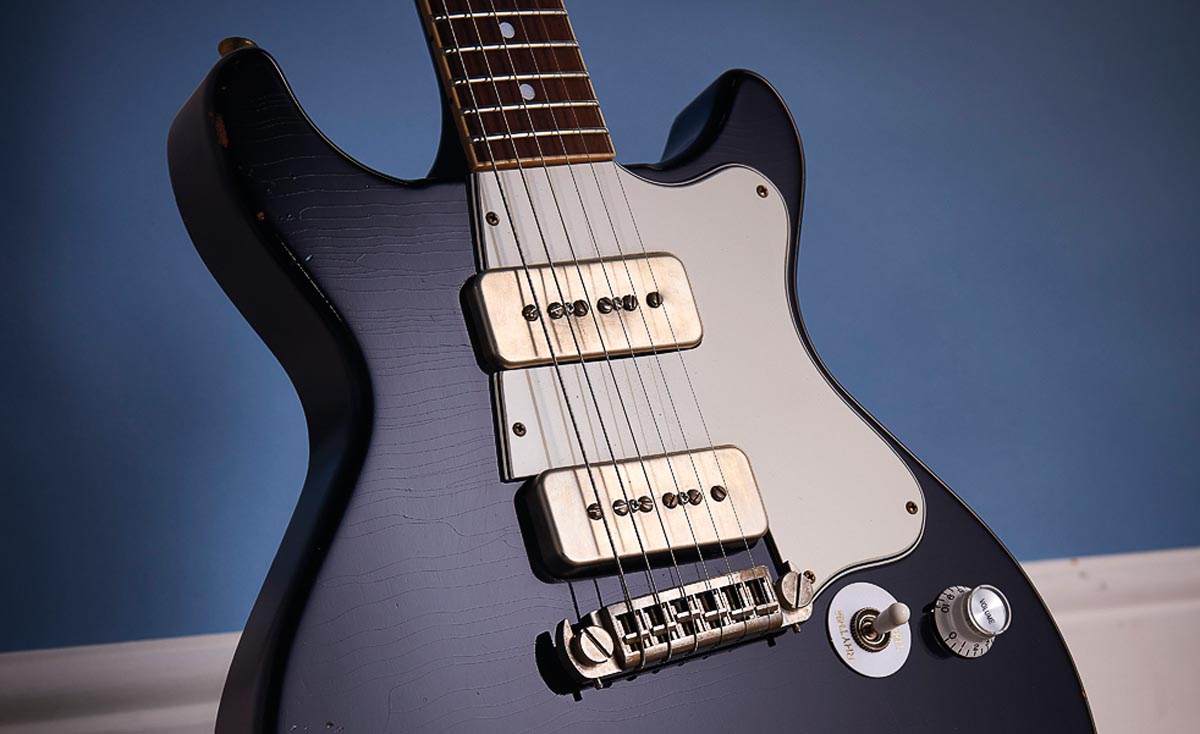
Dennis Fano at Novo Guitars in Nashville has developed his techniques and approaches since he began ageing new guitars in 2006. He agrees with Billy that creating a look of wear and tear on a new instrument is something of an art – and in the wrong hands, it can look pretty awful, he says.
“I just hope I’m doing a good job. I’ve heard everything from ‘That guitar looks like it’s been dragged behind a truck’ to ‘Just let it age on its own, naturally.’ There are a lot of detractors. But I do think it is an art form. There’s a lot of skill involved, and my techniques have constantly evolved. Now, it’s about how do we make these guitars better? How do we make them feel great? It’s about making them where you want to play them and you don’t want to put them down.”
Dennis Fano’s Novo Serus and Miris models are offered as standard with light or medium distress to the nitro finishes, and custom orders offer further levels of ageing. “At first, we built a good number of clean Serus guitars,” he says, and reckons that he and the team at Novo don’t care for cleaner guitars as much as the distressed ones.
“With a clean one, there’s always that feeling of ‘Okay, it’s clean, so don’t scratch it! Put it in the case, ship it to the dealer, and get it out of here.’ Whereas the distressed ones, well… you just want to play them.”
